EXTENDED TECHNIQUES
Below are some extended techniques possible on the flute. This is by no means all of them, but some of the most effective, and used techniques. Composers and flute players are continuing to dream up new ways to play the instrument.
*** Extended techniques are not a contemporary practice. All standard techniques were once "extended". Some techniques didn't make it mainstream for a long time. Even Bach used extended techniques for flute (see below Brandenburg 5).

There are a lot of amazing resources out there that go into extreme depths on these subjects. Seek them out! And look at scores that you find have results that are effective. With extended techniques, so much is in how you present it on the page, so consult as many flute players as possible to make sure you have a language that is as universal as possible to understand.
Check out these places to start:
Flute players who compose with extended techniques
Robert Dick
Ian Clarke
Greg Patillo
Harvey Solberger
Resources
Your local flute player!
https://newt.phys.unsw.edu.au/music/flute/
A few quick things to note:
With the exception of a few techniques, there is no standardized way to write a lot of the following techniques. BUT...you don't have to re-invent the wheel. Use the following examples as a guide and know that there is room for flexibility and improvement because there is no standard. An experienced player will have a "library" of extended technique sounds at their disposal
(This is similar to how there is no standardized chart for Baroque ornaments. Many of these are similar, but they are not the same. Check out the different ornament charts from:
Couperin
Bach
Rameau
Hotteterre
Quantz
Missing something you need? Reach out and request a description of any extended technique not listed.
air sounds
Air sounds are some of the most effective extended techniques on the flute and encompass a lot of different types of sound that can be created by both shaping the mouth, using different syllables, and altering the direction and amount of air that enters the tube.
I recommend that if you are writing for the flute and want to use air sounds, make yourself a PVC pipe flute, or buy a cheap metal $100 student level instrument (readily available on eBay) and experiment. Figure out what works/doesn’t work by testing things out yourself. There are many air sound possibilities and you will be able to write down what you want if you can achieve it yourself. Bonus is, you don’t have to make a true “sound” on the flute in order to make an air sound.
Full air/Syllabic air sounds (will have residual pitch, but no “real” pitch : Hard consonants work really well here, especially if you want a hard articulation: Ch, Sh, K, P, T, Shu. Open vowels are harder, but can produce soft attacks (these often have to have some sort of S involved that helps to keep the air “dirty”.)
Half pitch/half sound : This can be accomplished at varying degrees of severity. Basically, it’s the same idea as listening to a beginner or a saxophone doublers on the flute. You keep your lip muscles loose enough that the sound gets muddy and airy. This can be hard for professional flute players to do because they have literally spent years trying to get the air out of their sound. It is also quite difficult (and sometimes impossible) to do in the 2nd and 3rd octaves, because the loose embouchure will mean that the pitch will not have enough air speed to get to the 2nd and 3rd octaves.
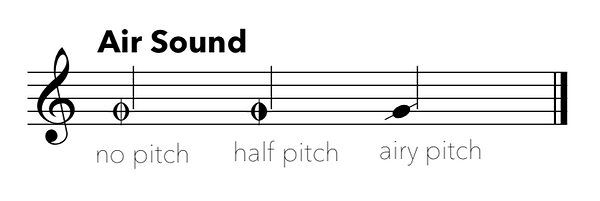
circular breathing
Circular breathing has been used since the earliest days of the flute (JS Bach’s Allemande from his solo flute Partita was apparently circular breathed by Pierre-Gabriel Buffardin in 1718) it still is not a technique that is required of flute players. In fact, I would wager that only 5% of flute players (at most) know how to circular breathe. I would say it is a good rule of thumb NOT to write a piece that requires circular breathing unless you are working with a flutist who can circular breathe. This is very important because circular breathing cannot be done on all notes or all instances. FYI, flute players generally see an indication to circular breathe as optional.
flutter tonguing
Can be achieved either by rolling the tongue, or in the throat. Most players can do only one of these (some physically cannot achieve one or the other) so please do not indicate which one you want. A good flute player will be able to get your desired effect using either technique.
Flutter tonguing can be achieved on any note in the flute range, but will be a little more challenging (and quieter) in the lower register of the instrument. It can also be done in combination with an air sound, or into the closed mouth hole of the flute.
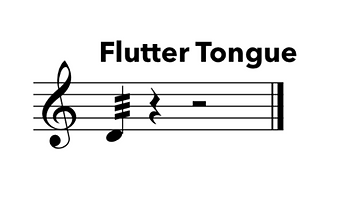
harmonics
Harmonics can give some of the most beautiful colours on the flute, but I would reserve them for solo pieces, or quiet moments in an ensemble piece, as they are often weaker in sound than regular notes. Please see the chart below for all of the possible harmonics.

harmonic gliss
Created in a similar way to the jet whistle by blowing air into the covered mouth-hole and shooting it around the tube at varying speeds so that it hits multiple points on the harmonic overtone series. Matthias Pintscher and Philippe Hurel are fans of this.

jet whistle
Made famous by Villa-Lobos’ piece for flute and cello, Assobio à Jato (The Jet Whistle) which features the effect at the very end of the third movement.


key clicks
Should be written only in the first octave of the instrument. It is not possible to have a second octave key click as the second and third octaves are achieved only by pushing the air stream to the higher harmonics.
The longer the pipe, the more resonant the key click….thus the most resonant are the lowest notes of the first octave.
***Key clicks should be written only in the first octave as you cannot create a key click that gives a pitch for any note that isn’t a fundamental
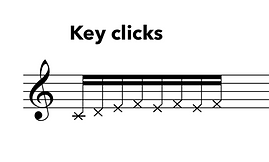
key slaps
A quiet, metallic sounding “thunk” that comes from aggressively closing a tone hole, creating an echo inside the tube. Key slaps are most effective using the right hand (as the tube is longer and has more resonance). You can add a key slap to a note to give it a little more articulation, or you can key slap without any air sound.
Key slaps were first used by Edgar Varese in Density 21.5, and also used extensively in Berio’s Sequenza (see below).
***Key slaps should be written only in the first octave as you cannot create a key slap that gives a pitch for any note that isn’t a fundamental



multiphonics
Definition: When a player splits the airstream so that it hits notes in both the fundamental range, and harmonic range at the same time (or two different harmonic ranges). This happens when one uses a forked, or vented, fingering that allows the note to split into more than one register. As a result, playing multi phonics using the lowest notes of the flute register are not possible.
Always put your desired multiphonic fingering in the part. Please do not just write the notes you want and expect the performer to find the fingering that will produce those pitches. Generally, if you are writing multiphonics into your music, I recommend testing them with a performer to make sure they work as you intend as many multiphonics merely approximate the written pitches, are quite quiet, and are unpredictable.
Multiphonic Resources (all to be consulted with a flute player)
Robert Dick: The Other Flute


singing and playing
Best in 3rds/5ths
Difficult to control pitch in unison/octaves
Please always take into account different vocal ranges. Some composers will give different versions for different voice types, others just indicate that it is ok to “sing” in whichever octave is comfortable for your voice.
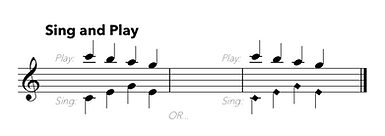
trimbril trill (bisbigliando)
Trills that use slightly different fingerings for the same pitch. This is only possible in the second and third octaves, as timbral trills are usually created by playing successive fingerlings for the same note. This is often done with different harmonics, or different alternate fingerings.

tongue ram
Definition: When a flute player creates a vacuum seal with the mouth tone hole, creating a “thunk” sound.
Tongue Ram’s sound a major 7th below what is written. Do not put the “sounding” note in the flute part. Just indicate which note we should play to achieve the note you are looking for along with a note head that specifies “tongue ram”. Successive tongue rams are difficult to achieve. I recommend not going above 80bpm/tongue ram.
***Tongue Ram’s should be written only be in the first octave as you cannot create a tongue ram on any note that isn’t a fundamental


tongue pizz (slap)
I see these two terms interchangeably in scores. When doing this, we are trying to emulate as best as possible, the sound of a string pizz. You can do this using a variety of different syllables/tongue positions that will create slightly different resonances, dynamics, and colors. Like with tongue rams, these are hard to do in quick succession as they require “re-setting” the tongue position between each one. An easy way to be safe, is ask yourself if a string player can pizz those notes that fast....if they can, great! So can we. If not...split them between two people. The speed should not exceed that which you would ask a string player to pizz on the same string in succession.
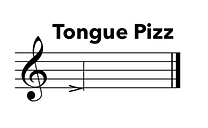

tremolo
Generally keep within the same octave as you can’t really tremolo very fast between two different octaves (because of the harmonic airstream difference.)
quarter-tones
Theobold Boehm designed the modern flute as an extremely accurate 12-tone, chromatic instrument that eliminated (as much as possible) the ability for large pitch variation in favor of incredible pitch stability that could match equal temperament instruments. However, modern flute players are able to achieve quarter-tones through lip-bending notes, or using specific quarter-tone fingerings.
Quarter tones are possible on the flute largely due to the open tone holes. Quarter tones on auxiliary flutes often use entirely different fingerings, and are very different, and sometimes quite difficult to achieve.
Piccolo: Great at lip bends - you can do some very large bends (up to a minor third), but because there are no tone holes, one cannot do the same quarter tone fingerings as the modern flute (some are possible, just not all.)
Alto Flute: Lip bends are possible, but will not give you as large of bend as on the smaller flutes. The alto flute does not have tone holes, so many of the quartertone fingerings from the regular flute do not apply.
Bass Flute: Similarly to the alto flute, lip bends are possible, but have an even more limited range (basically as the tube gets bigger, it is harder to bend further). The bass flute does not have tone holes, so quartertone fingerings often do not apply.
There are no fingerings for quarter tones for the lowest notes on a flute (all fingers are down...so there's not much one can do to alter). One can lip-bend to some extent, but it is not as drastic, and can sometimes be quite difficult to get the desired pitch.
Lip-bend VS Fingered
Only specify a lip-bend vs. a fingered quarter-tone if you are looking for a very specific color of sound (this is usually only needed if you are asking for a very specific fingering.) Generally, a player will choose depending on which they are most comfortable with/what works best on their instrument.
Lip-bending for chromatic quarter tones
-
General rule: the longer the tube, the less drastic the bend
-
Generally much easier to bend down than up
-
Bending down: able to almost always get a full half step. Volume will diminish. Will not carry as well.
-
Bending up: possible to get a half step if the bend is accompanied by a crescendo. Will be an airier sound.
Lip-bending to achieve a quarter tone from one non-chromatic tones to another
-
If you can keep the bend direction consistent, the player will be able to achieve at a faster tempo. If you are asking someone to play a bended quarter tone flat followed immediately by a bended quarter tone sharp, it will take them slightly longer as one has to move the entire flute on the chin to achieve this.
Fingered
-
Generally a little trickier than bending the pitch because one has to learn an entirely new fingering.
-
Quarter tone fingerings are, similar to the baroque flute, forked or “weak” fingerings that are often unstable with a very limited range of dynamic. There are often more than one options for each note, so make sure to check with a flute player to see which one you like best. If you have a specific sound in mind, please put the fingering chart above the note in the part.
*Brannen-Cooper flute makers do make a quarter-tone flute (made for Robert Dick.) I don’t know anyone who actually plays on this, and think it was more of a fun project for them (largely because it is prohibitively expensive to purchase. He also designed a glissando headjoint, which again, very few people use, but is pretty cool.)
whistle tones
Are very quiet and very difficult to control. I’ve rarely found that these give a composer what they want as they are almost always inaudible in the context which someone writes them in.






